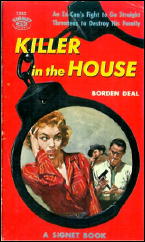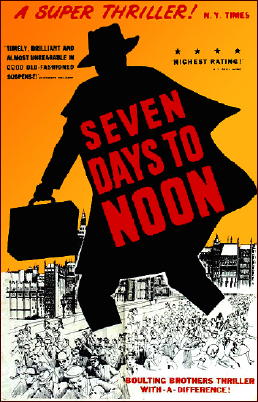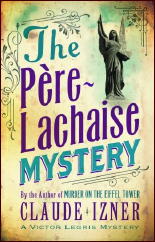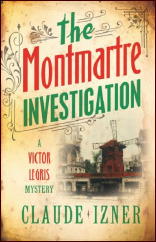March 2010
Monthly Archive
Wed 31 Mar 2010
REVIEWED BY GEOFF BRADLEY:
MURDERLAND. ITV, UK; 3-episode miniseries: 19 October, 26 October, 2 November 2009. Robbie Coltrane, Amanda Hale, Bel Powley, Sharon Small, Lorraine Ashbourne, Nicholas Gleaves, Lucy Cohu, Yasmin Paige. Screenplay: David Pirie. Director: Catherine Morshead.

This was a single story, written by David Pirie and told over three one-hour parts (less adverts).
In the first we see a young woman, on the brink of marriage, who goes to retired detective Hain (played by Robbie Coltrane), the man who investigated her mother’s murder 15 years before.
We see the murder and the investigation through her young eyes as she discovers her mother was a prostitute working at a shabby massage parlour.
In the second part we see the investigation through the eyes of Hain and we realise much more of what has gone on before; in the third episode we see the story brought up to date as new witnesses are discovered and the killer finally brought to justice.
This was a very watchable piece of television which certainly engaged my interest and the time went very quickly. However like many programmes nowadays, I wasn’t entirely convinced at the end that it all made sense — for example it seemed a little odd that the workings of the massage parlour were unchanged after 15 years.
Still it was a commendable effort and I enjoyed watching it.
Wed 31 Mar 2010
Posted by Steve under
ReviewsNo Comments
Reviewed by DAVID L. VINEYARD:
ERIC VAN LUSTBADER – Last Snow. Forge Books, hardcover, February 2010.
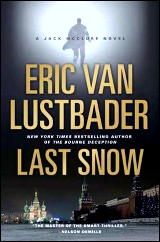
Eric Van Lustbader made a big splash with the first book in his Nicholas Linnear series, The Ninja, and staked out a place for himself in the best selling thriller stakes with tales of intrigue and adventure that usually involved his heroes in adventures with an Asian background.
When that ran its course he seemed to founder a bit, made an ill advised attempt to change his name from Eric Van Lustbader to Eric Lustbader, and for a while seemed to have dropped out of the game. Recently he came back strongly, however, with Testament, and was chosen by the Robert Ludlum estate to continue the popular and lucrative Jason Bourne franchise.
His books have always been strong on compelling narrative and notable for a sensuality missing in many of his contemporaries works.
Last Snow is the second book in a series that began with First Daughter (Forge, 2008), and like so many series today it’s almost impossible to read one without some reference to the other, so I’ll briefly outline the events in the first book as they apply here.
Jack McClure is a tough ATF agent whose best friend is President-elect Edward Carson. Jack’s daughter Emma has died, the tragedy putting an end to his marriage and leaving Jack devastated, and one of the few people who feels the same as he does is Edward Carson’s daughter Alli, Emma’s roommate in college. When Alli is kidnapped it’s only natural the newly elected president turns to his old friend for help.
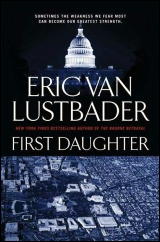
Political winds are stirring up trouble in regard to Alli Carson’s kidnapping. The outgoing administration wants their strong right wing Christian philosophy to continue to dominate the public debate and are pushing a moderate and increasingly powerful secularist movement as the villains even though the evidence points to a more radical secularist group. (Has there been a radical secularist movement since Lenin?)
The action is well done and the characterization fine, but over all the politics are cartoonish and a bit silly really. This is no Seven Days in May or Advise and Consent. Seemingly both the far right and the far left have completely forgotten how to write political thrillers, since the right-leaning writers currently churning this sort of thing out are just as bad.
A quick course in Richard Condon seems desperately needed for both sides. (Not that Condon was never outrageous, but then that was part of his charm — none of these current writers — Lustbader included — are remotely Richard Condon —most of them make you miss William LeQueux and E. Philips Oppenheim.)
In any case Jack (notice how many of these guys are called Jack since Jack Bauer and 24?) saves the day, and there is some suspense along the way, despite the cartoonish politics. Lustbader writes readable page-turning bestseller prose.
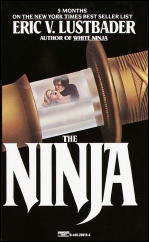
Last Snow picks up with Edward Carson president. Jack is trying to put his life back together again, and Alli, who suffers from Graves disease and looks sixteen instead of the twenty-two she really is, tends to cling to him after her ordeal. (This is the sort of book where everyone has some defining problem in lieu of characterization — it’s so much easier to give someone a problem than a character.)
But Carson also relies on Jack, and when a US senator who was supposed to be in the Ukraine shows up dead in Capri under questionable circumstances, he asks Jack to investigate. Jack is with the Presidential party in Moscow.
An interesting character note about Jack is that he is dyslexic, and through his mentor has learned to use that handicap as an advantage — his mind works differently and he uses that to solve puzzles that others can’t even as he struggles with the everyday world of paper work. It’s a nice touch, and Lustbader makes the most of it creating a reasonable and intelligent explanation for Jack’s considerable talents, even though what I wrote earlier of using these sort of things as gimmicks still holds. One character with a gimmick is fine. More than one and it becomes a crutch.
If there is one major flaw here it’s that the book suffers from best seller shorthand.
Berns was Carson’s man in the Senate, and he fears the former administration may use this against him … may even have killed Berns. Jack is to find out what he was doing in the Ukraine and how he died in Capri. His only clue is the name of the man Berns met in the Ukraine, one R. Rostov.
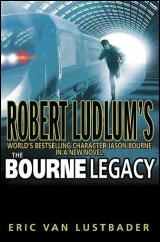
But before he can leave Moscow Jack meets Annika, a FSB agent (the FSB is the new KGB — Annika’s “problem” is she was sexually abused and tortured by her older brother as a child), and they are drawn together and thrown together after an encounter in an alley with the local Russian Mafia. Annika needs to get out of town and goes with Jack, and when they are in the air of the private plane provided by the President, who shows up but Alli.
It’s that sort of a book.
I won’t go into a good deal more. Jack is being played as part of a greater game, but using his skills and instincts, he manages to outwit the enemy and save the day. He is drawn even more closely to Alli, has a romance with Annika, and as might be expected, he saves the day while facing enemies on all sides.
All in all, a pleasant diversion — a bit better written than most if a shade on the mechanical side. There is even a twist at the end leading to the next book — a twist completely out of left field, that presages major changes for Jack and Alli, but as I said, that’s the next season of 24 — I mean the next book in the series.
I don’t want to mislead anyone. This is well done and entertaining. It could be a bit more with some effort, but it’s what the publisher and Lustbader’s public wants and it’s hard to fault a writer for delivering what was expected of him.
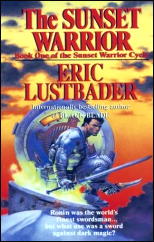
I’ll keep reading Lustbader, but I’ll probably keep wishing he took this to the next level as well. Whatever else, he’s a better writer than most of his fellow workers in the bestseller ghetto, and no one can say he doesn’t know how to keep you turning the pages.
I just wish sometimes the surprises were less the usual kind found in thrillers, and more the kind a really creative writer is capable of.
But some kudos to Lustbader that he is good enough I think he is capable of more.
Or maybe I’ve read too many of these and become jaded, though reading this sort of thing Jack McClure’s dyslexia doesn’t always seem such a curse after all.
Wed 31 Mar 2010
Posted by Steve under
Reviews[4] Comments
ROBERT CRAIS – Indigo Slam. Ballantine, paperback reprint; 1st printing, February 2003. Hyperion, hardcover, June 1997.
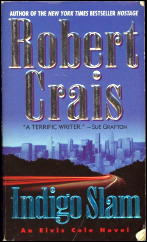
To begin with, there are two small mysteries here. First, why did it take so long for a hot book by a hot author to make the move from hardcover to paperback? (At the moment, the paperback is ranked 4087th in Amazon’s listings, a fact which will be far out of date by the time you read this, but as far as private eye detective paperbacks go, this is Pretty Good.)
And secondly, since this is the seventh Elvis Cole novel, why it is that this is the first one I’ve read? I have no answer. I do have a large backlog of books to read, though — is that an excuse? I probably should have started with the first one (The Monkey’s Raincoat, a paperback original from Bantam in 1987), but this one just came out, it looked inviting, and so in I dove.
Refreshing it was, too. Crais is a smooth writer, and he manages to juggle a couple of unrelated plot lines in quite acceptable fashion. If nothing else, Cole is good at multi-tasking. What gets the book going and is its main point of focus thereafter are Cole’s clients, three young children whose father is missing. Thanks to the short prologue, we know more than Elvis does, but he fills in the gap soon enough: their dad is a drop-out from a Federal witness protection program.
In backtracking Clark Hewitt’s trail, Cole has help from his laconic, all-purpose partner, Joe Pike — whether they admit it or not, an entire generation of private eye writers has definitely been influenced by Robert B. Parker — and the stakes keep growing higher and higher. I’ll skip the details. Read the book.
In between run-in’s with various mobsters of every ilk, almost all of them with guns, Lucy, the love of Elvis’s life, is having trouble with her ex, and in the middle, of course, is our hero.
If the story itself is little more than ordinary, the reason is because the people who are in it who are quite remarkable. The kids who Elvis is working for are superbly drawn: the youngest rather quiet and shy, the boy in the middle suitably bratty, and the oldest, well at 15, she’s been their mother of the other two for quite some time, and as such, she’s simply terrific.
— June 2003
[UPDATE] 03-31-10. The current Amazon ranking for the paperback edition is #16,211, not bad for a mystery that’s nearly 13 years old (but still in print). Unfortunately for me, this is still the only book by Robert Crais that I’ve read. Re-reading my review just now, I’m stumped. I really am.
Tue 30 Mar 2010
Posted by Steve under
Reviews[2] Comments
A REVIEW BY MARYELL CLEARY:
AGATHA CHRISTIE, DOROTHY L. SAYERS, E. C. BENTLEY and Other Distinguished Members of the Detection Club – The Scoop [and] Behind the Screen. Introduction by Julian Symons. Harper & Row, hardcover, 1983. Charter, reprint paperback, 1984. First published by Victor Gollancz, UK, hardcover, 1983.
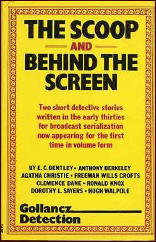
According to Julian Symons, the Detection Club is “a slew of crime writers, slew being surely the right collective noun.”
To raise money to acquire club premises, the members collectively wrote two crime novels to be read on BBC radio, each made up of chapters by different authors. These stories have remained buried in the files of the BBC’s magazine, The Listener, until now.
It must have been fun to be a mystery fan in the 30’s: Imagine being able to hear Christie, Sayers, Bentley, Berkeley, Knox, Dane, et al reading their own chapters over the air!
And it must have been great fun writing them too. Mostly they are just fun, not to be taken seriously as mystery and detection stories. Perhaps the noted authors took the whole thing as a kind of game, a spoof on what they did for a living.
The Scoop has a passable plot and cliched characters. The less said about the plot and characters of Behind the Screen the better. But taken as spoofs, just for fun, they are fun. And they are interesting examples of their authors’ work when they let down their hair and their standards.
— Reprinted from
The Poisoned Pen, Vol. 6, No. 4, Fall 1986
Tue 30 Mar 2010
REVIEWED BY WALTER ALBERT:
AFRAID TO TALK. Universal, 1932. Sidney Fox, Eric Linden, Louis Calhern, Tully Marshall, Edward Arnold, George Meeker, Berton Churchill, Robert Warwick, Frank Sheridan, Mayo Methot, Matt McHugh, Thomas Jackson, Gustav von Seyffertitz, Joyce Compton, George Chandler, Arthur Housman, King Baggot, Walter Brennan, Margaret Lindsay. Screenplay by Tom Reed, based on the play Merry Go Round by Albert Maltz and George Sklar. Photography: Karl Freund; editor: Milton Carruth; art direction: Charles D. Hall and Edgar G. Ulmer. Director: Edward L. Cahn. Shown at Cinecon 45, Hollywood CA, September 2009.
This superbly crafted crime thriller hit the Saturday evening audience with all the force of a speeding train and never let up in its character-driven 69 minute drive.
Eric Linden and Sidney Fox, popular young players of the time, are the titular stars, with Linden the witness to a gangland killing who, after being promised immunity for his testimony, is framed by a corrupt Assistant D. A. (Louis Calhern).
There’s not a weak link in the cast, but Calhern, a smooth career politician with not a shred of morality, gives an unforgettable performance. And the final, ironic scene undercuts any sense that the era of corrupt politics is finally over.
Tue 30 Mar 2010
REVIEWED BY DAN STUMPF:
LEE BORDEN – The Secret of Sylvia. Gold Medal #744, paperback original; 1st printing, February 1958.
I still remember seeing Lee Borden’s The Secret of Sylvia on the paperback rack next to the tube tester at my local drugstore back in the early 60s, and the effect it had on this callow youth from the Midwest.
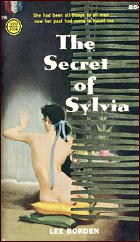
So when it surfaced recently from the swamp that is my library, I decided to actually read the thing.
Secret is more directly about Sex than most Gold Medal originals. Oh, there’s the usual quota of drinking, fighting, shooting and other Rugged Manly Action, but this is basically about Sex.
The nameless narrator of the tale, Sylvia’s husband, starts out on his way home to kill his wife, then flashes back to the reasons why: apparently some time earlier he learned that Sylvia put it about a bit before they were married, so he set himself to looking into her past.
Whereupon the book dissolves into four separate parts, each narrated by a former lover. Sylvia’s husband never tells us how he — a bookseller by trade — found these guys or how he got them to spill their intimate secrets all over him; we’re just supposed to take it on faith.
Likewise his determination to kill Sylvia is something neither he nor author Borden spells out very convincingly. Well, there’s some dialogue (a lot of dialogue, actually) late in the book supposedly delving into the psychology of the thing, but nothing very convincing.
I get the feeling, though, that the potential readers of Secret of Sylvia probably weren’t looking for anything very deep or convincing; this was frankly soft core porn, and probably … how shall I put this? — probably satisfied the one-handed readers in its day.
Bibliographic Data: [Expanded from the Revised Crime Fiction IV, by Allen J. Hubin]
BORDEN, LEE. Pseudonym of Borden Deal, 1922-1985.
The Secret of Sylvia. Gold Medal 744, pbo, Feb 1958.
The Devil’s Whisper. Avon T-520 , pbo, 1961.
DEAL, BORDEN. 1922-1985. Born Loysé Youth Deal; pseudonym: Lee Borden.
Killer in the House. Signet 1383, pbo, Apr 1957.
A Long Way to Go. Doubleday, hc, 1965.
-Adventure. Doubleday, hc, 1978.
Mon 29 Mar 2010
Posted by Steve under
Reviews[2] Comments
A REVIEW BY MARY REED:
CATHERINE LOUISA PIRKIS – The Experiences of Loveday Brooke, Lady Detective. Hutchinson, UK. hardcover, 1894. Dover, US, trade paperback, 1986.
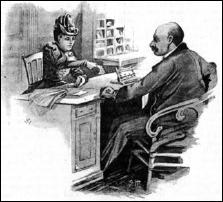
This collection of stories appeared in the early 1890s and features Miss Loveday Brooke, who works for Ebenezer Dyer, head of a detective agency in Lynch Court, off London’s Fleet Street.
Miss Brooke is in her thirties and began detecting as the result of an event (not described) by which she was “thrown upon the world penniless and all but friendless”.
With no way to earn a living she chose this particular line of work, which had the effect of cutting her off from her friends and original position in society.
By this we can safely deduce she is well bred, the more so as she has rooms in Gower Street and employs a maid. Miss Brooke is nondescript in appearance, making her occasional impersonation of, for example, a nursery governess seeking work or a lady house decorator easily carried off.
A few words about her various adventures:
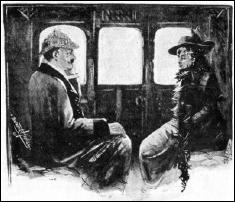
“The Black Bag Left on a Door-Step”
Craigen Court is burgled, Lady Cathrow’s jewels stolen, and her French maid suspected of having a hand in the job. Is there a connection between the theft and a bag whose contents include clerical trappings and a suicide note found on a doorstep not far away?
“The Murder at Troyte’s Hill”
Highly unpopular Alexander Henderson, lodgekeeper at Troyte’s Hill, is found murdered in his bedroom, which has been turned not so much topsy turvey as completely rearranged in a bizarre fashion, with bed-clothes up the chimney, mantelpiece ornaments arranged in a line on the floor, the clock on its head, and so on. Yet nothing has been stolen.
“The Redhill Sisterhood”
Sister Monica has rented a house in fever-haunted Paved Court in Redhill, probably not the best location for the Sisterbood’s home for crippled orphans. The Sisters take children begging around local villages each day and strange to relate, burglaries seem to follow in their tracks.
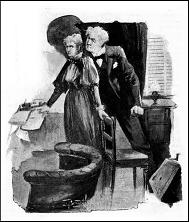
“A Princess’s Vengeance”
Major Druce is engaged to the Turkish Princess Dullah-Veih, but his gaze has been wandering to his mother’s amanuensis Mlle Cunier. Now the latter has disappeared, taking only her coat and hat …
“Drawn Daggers”
Miss Monroe, staying with the Revd and Mrs Hawkes, has lost a valuable diamond necklace but she and Mrs Hawkes wish the matter to be hushed up. Now Mr Hawke is receiving anonymous drawings of daggers, and with his wife conveniently away, he engages Loveday to look into the matter.
“The Ghost of Fountain Lane”
On holiday in Brighton, Miss Brooke investigates the matter of a blank cheque stolen from Revd Charles Turner, cashed for £600, and returned with the mysterious annotation 144,000 on its reverse. Then there’s the ghost….
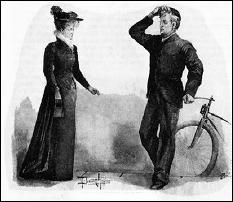
“Missing!”
Miss Irene Golding of Langford Hall, Leicestershire, has disappeared and £500 is offered for aid in finding her. Her Italian maid may know more than she is willing to reveal. The final plot twist will be too weak for many to accept.
My verdict: The collection is not terribly sparkling and occasionally does not play fair with the reader, although its explanations of Miss Brooke’s chain of deductions are reasonable and demonstrate one of her main traits: common sense.
The stories will however certainly be an interesting read when viewed as an early example of the female detective, although sometimes too slowly paced for most modern readers.
Illustrated etext: http://digital.library.upenn.edu/women/pirkis/brooke/brooke.html
Editorial Comment: For more on the author and her Loveday Brooke stories, see Mike Grost’s Classic Mystery and Detection website.
Mon 29 Mar 2010
A TV Review by MIKE TOONEY:
“House Guest.” An episode of The Alfred Hitchcock Hour (Season 1, Episode 8). First air date: 8 November 1962. MacDonald Carey, Robert Sterling, Karl Swenson, Peggy McCay, Adele Mara, Robert Armstrong, Billy Mumy. Writers: Marc Brandell and Henry Slesar. Based on the novel The Golden Deed (1960) by Andrew Garve. Director: Alan Crosland, Jr.
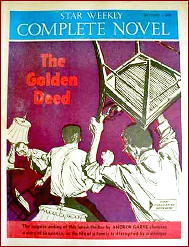
Sally Mitchell (Peggy McCay) and her son Tony (Billy Mumy) are at the beach; for some reason Tony insists on swimming far offshore (it’s only much later that we find out why), where he nearly drowns. Only the intervention of Ray Roscoe (Robert Sterling) keeps him from going under.
Sally, needless to say, is profusely grateful to Ray and tells her husband John (MacDonald Carey), who offers Ray a temporary place to stay until he can get on his feet, financially speaking. According to Ray, he’s just out of the Air Force and looking for an orange grove to invest in.
Soon, however, Ray shows his true colors, making barely concealed passes at Sally and neglecting to find work. He even tries to coerce John into paying him to leave.
Ray’s behavior deteriorates even further when, while driving John’s car, he gets into a fender bender with George Sherston (Karl Swenson) and his wife Eve (Adele Mara). Sally can’t help but notice Ray now making passes at Eve, just like he did with her.
But George isn’t blind, either. After Ray reportedly gets too physical with Eve and she scratches his face, an enraged George confronts him just outside John’s house. The two are in a slugfest when John intervenes, trying to stop it. Then a terrible accident occurs: When John pushes him a little too hard, Ray falls against a car bumper. George checks the body for life signs.
The thing to do now would be to call the police, but George argues that it would be nearly impossible to prove it wasn’t premeditated murder, considering Ray’s sexual advances and attempts at blackmail. They all agree the best action would be to bury their “accident victim” and pretend he’s moved on.
Funny thing about Ray’s accident, though — it’s exactly according to plan ….
Karl Swenson was all over television for three decades; he usually played in Westerns (e.g., Little House on the Prairie, Bonanza, Cimarron Strip, Gunsmoke), but not always (The Mod Squad, Barnaby Jones, Hawaii Five-O, Mission: Impossible).
Robert Sterling had a few criminous credits: Johnny Eager (1941), The Get-Away (1941), and Bunco Squad (1950) — but he usually played lightweight comedy roles or good guys: the Topper TV series (1953-55), Ichabod and Me (series, 1961-62), and the first captain of the U.S.O.S Seaview in Voyage to the Bottom of the Sea (1961).
As for MacDonald Carey: Shadow of a Doubt (1943), the TV series Lock Up (1959-61), four appearances on Burke’s Law, and two on Murder, She Wrote — including what some regard as the smartest and trickiest episode of that series, “Trial by Error” (1986).
Hulu: http://www.imdb.com/video/hulu/vi886571033/
Editorial Comment: According to IMDB, Andrew Garve’s The Golden Deed was also the basis for the first episode of a summer replacement series on NBC called Moment of Fear (1 July 1960; Season 1, Episode 1). Starring in the program were Macdonald Carey, in apparently the same role, Nina Foch, and Robert Redford.
Sun 28 Mar 2010
A MOVIE REVIEW BY DAVID L. VINEYARD:
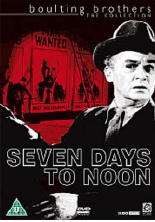
SEVEN DAYS TO NOON. British Lion Films, 1950. Barry Jones, Olive Sloane, André Morell, Sheila Manahan, Hugh Cross, Joan Hickson, Geoffrey Keen, Victor Maddern. Screenplay: Roy Boulting and Frank Harvey. Original Screen Story by Paul Dehn and James Bernard. Directors: John and Roy Boulting.
This taut little suspense film is one of the best of its kind ever made. With an Oscar-winning original story by Paul Dehn and James Bernard (best known for composing many of the scores for the Hammer horror films) and a screenplay by co-director Roy Boulting and novelist Frank Harvey (White Mercenaries), the film is an achingly suspenseful exercise in nuclear extortion as a soft-spoken scientist holds London hostage amidst a nationwide manhunt, done in a variation of the docu-noir style of many American films of the period.
The film also won the British Oscar, the BAFTA, for best picture and John and Roy Boulting received best directing nominations from the Venice Film Festival.
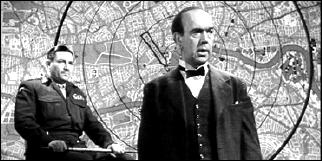
Barry Jones (Brigadoon, Demetrius and the Gladiator, War and Peace) is the scientist, Professor Willington, who disappears from his job at a nuclear research facility and leaves a letter to the Prime Minister (Ronald Adam) stating he will destroy London in seven days at noon on the seventh day unless his demands for nuclear disarmament are met.
The world was made in seven days, and London will be destroyed in seven days unless mankind stops the madness of nuclear research is the disturbed professor’s demand.
Superintendent Folland (Morell) of the Yard and Stephen Lane (Hugh Cross), the professor’s research assistant and future son-in-law, head the nationwide manhunt once it is discovered that along with the professor a suitcase nuclear device is missing. (They didn’t exist then and still don’t now, but where would these films be without them?)
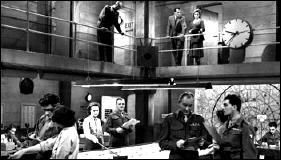
The film focuses less on the hunt itself than on Willington as he flees to London and interacts with a handful of people including a somewhat flowsy Cockney woman (Olive Sloane) and his landlady (Joan Hickson — Miss Marple). The professor’s ideals are contrasted with the ordinary real people they threaten in a small Cockney neighborhood — not saints or even the salt of the earth, but human beings unaware their very existence is threatened.
As the pressure intensifies and the noon deadline approaches, London is evacuated and the shots of the empty streets are both haunting and striking. Meanwhile the authorities close in and the professor’s mental state deteriorates more rapidly. The final confrontation in a church is both evocative and tense.
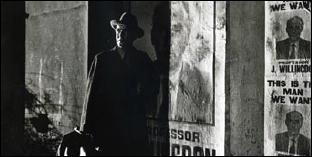
Solid as this is as a suspense film, there is more to it, which perhaps explains why it has a resonance still today. Jones is neither an egotist nor a monster, but a kindly and gentle man driven to the ultimate act of terror by the daily horror of the work he pursues. Morell is presented as a human and understanding policeman, and everyone involved seems weighted down by the horror of both the potential destruction and the morality involved.
Willington is a madman and a terrorist, but a real effort is made to understand his mental breakdown and stop him without killing him; something it becomes increasingly obvious they may not be able to accomplish.
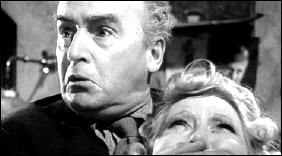
Seven Days to Noon is something more than a suspense film, an early example of the anti-nuclear movement, then in its infancy, and also a meditation on the beginnings of the arms race that would reach its high (or low) point with the Cuban Missile Crisis. The film bothers to ask important questions, and to force viewers to ask who the real madman is — the professor unbalanced by the horror of his work, or the society blithely ignoring the apocalypse under its nose.
There are no easy answers here. Horrible as the Professor’s threat is it may be less horrible than the future he wants to prevent. The film never suggests such terrorism is justified, only that to an unhinged mind it may seem so.
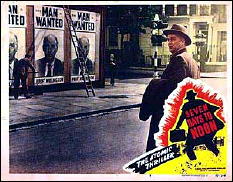
This story has been done countless times since, but seldom this well. There is an interesting contrast with a 1953 American film from Fred Sears and Ivan Tors, The 49th Man, an altogether pulpier (but entertaining) version of the A-bomb in the city story with a few nice paranoid twists and a good performance by John Ireland as an undercover operative.
But this film is neither shrill nor melodramatic; it is quiet and powerful, and it may be more relevant today than it was when it was made sixty years ago. It also offers a fascinating look at a London still marked by the bomb craters from WW II, at a time when you could actually conceive an orderly evacuation of a city the size of London.
Note: If you go to IMDb you will discover this is the first original film score by noted British film composer John Addison.
Sat 27 Mar 2010
REVIEWED BY WALTER ALBERT:
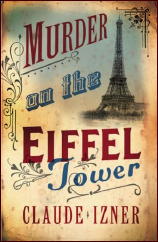
CLAUDE IZNER –
● Murder on the Eiffel Tower. St. Martin’s Press, hardcover, September 2008; trade paperback, September 2009.
● The Marais Assassin. Gallic Books, UK, 2009. No current US edition.
I’d earlier read The Pere Lachaise Mystery, the second in the series, and The Montmartre Investigation, the third. Murder on the Eiffel Tower is in fact the first, while The Marais Assassin is the fourth.
The amateur sleuth in the series is Victor Legris, a Parisian bookseller, who operates a shop with a partner, Kenji Mori, and a young shop assistant, Joseph Pignot (“Jojo”), a bright and ambitious lad who’s also a budding serial novelist and a fan of detective fiction.
The first novel is set in May 1889, at the time of the Paris Exposition, whose centerpiece attraction is the recently constructed Eiffel Tower, while the fourth takes place in 1892.
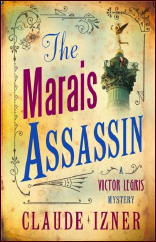
The series was an automatic choice for me since its setting in Belle Epoque Paris presents the French capital at its most captivating, a bustling international center of the arts, and, in Izner’s fervid imagination, the setting for a series of ingenious, bizarre murders.
In Eiffel, a series of apparently random deaths apparently caused by bee stings is seen by Victor as something more insidious, and in Marais the killing field stretches from rural England to Paris, with the spree occasioned by the theft of a goblet of apparently little value.
Victor is a relentless pursuer of the cunning murderers, but his heart often overrules his head, and his romantic entanglements are fortified by a strong vein of jealousy that any reader of Proust will appreciate.
Still, the virtues outweigh Victor’s weaknesses, which haven’t significantly reduced my enjoyment of the novels.
Bibliography:
* Mystere rue des Saints-Pères, 2003. (Murder on the Eiffel Tower)
* La disparue du Père-Lachaise, 2003. (The Pere-Lachaise Mystery)
* Le carrefour des Écrases, 2003. (The Montmartre Investigation)
* Le secret des Enfants-Rouges, 2004. (The Marais Assassin)
* Le léopard des Batignolles, 2005.
* Le talisman de la Villette, 2006.
* Rendez-vous passage d’Enfer, 2008.
From the Gallic Books website: “Claude Izner is the pen-name of two sisters, Liliane Korb and Laurence Lefèvre. Both booksellers on the banks of the Seine, they are experts on nineteenth-century Paris.”
Next Page »









